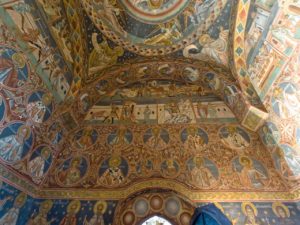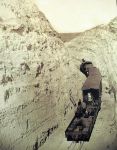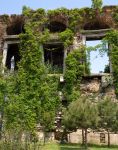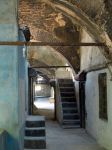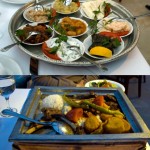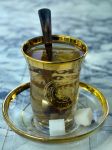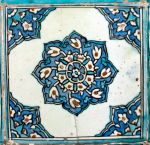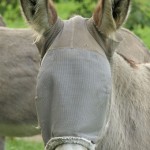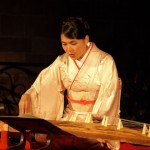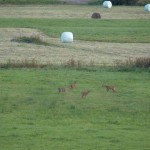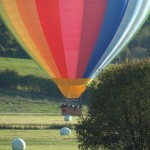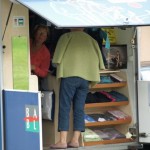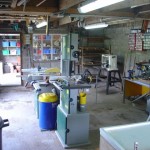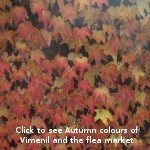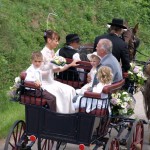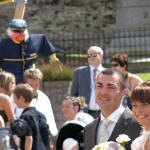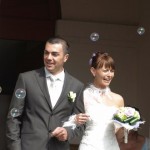To download a printable Adobe Acrobat version click on this link E2EYear7Weeks30-46.pdf (four A4 pages)
Clicking on one of the small photographs in the newsletter will open another window
Spring, according to our postman’s calendar, officially arrived a few days ago. And in brief recognition of this, the sun shone brightly, the cowslips and daffodils in the orchard came into bud, and the Venetian carnival came to Remiremont.
Remirement is a pleasant old abbey town on the Moselle, on the far side of the ski resort of Gérardmer. When we arrived, the main arcaded street was closed to traffic, for the elaborately costumed masked lords and ladies of yesteryear to saunter and pose for photographs.  Plumes, chiffon, lace, sequins, satins, brocades, paste jewellery flaunted in a riot of scarlet, snow white, lime green, gold, silver, velvety black, Chelsea blue, dove grey and flaming orange. Behind the elaborate, bejewelled masks, dark, mysterious eyes gazed soulfully as ladies inclined their heads gracefully to the cameras and gentlemen bowed and kissed the spectators’ hands. There were a few cats with long claws and a sinister beaked bird, but it was the elegant Venetian aristocracy who were the main attraction, and the crowds pressed in on them so that they could hardly pass.
Plumes, chiffon, lace, sequins, satins, brocades, paste jewellery flaunted in a riot of scarlet, snow white, lime green, gold, silver, velvety black, Chelsea blue, dove grey and flaming orange. Behind the elaborate, bejewelled masks, dark, mysterious eyes gazed soulfully as ladies inclined their heads gracefully to the cameras and gentlemen bowed and kissed the spectators’ hands. There were a few cats with long claws and a sinister beaked bird, but it was the elegant Venetian aristocracy who were the main attraction, and the crowds pressed in on them so that they could hardly pass.
But it was no more than a colourful interlude. The day after the Venetians came to Remiremont, the gales returned and now the driving snow, hail and rain have obscured the hills. This was the kind of weather we had back in February, when I joined the Ste Marguerite pensioners’ outing to the appropriate sounding production of “Venise sous neige”. An amateur theatre group over the hills in Alsace have a cunning way of raking in an audience. They provide a three-course lunch in the village hall beforehand, complete with aperitif, wine and coffee, then their audience sit back in a receptive frame of mind, ready to laugh at the silliest of farces. John had assumed it would be a mainly ladies’ outing, but of course, with Sunday lunch provided, the men were all there too. But, alas, there were no masked Venetian ladies to be seen. The plot involved a young French couple, who have just had an argument, dining with a couple of lovey-dovey friends of the man. As the visiting woman refuses to talk after the argument, the hosts assume she is foreign and she maliciously builds on this misunderstanding till they end up giving her all their favourite possessions for the poor deprived country she is assumed to have fled from, including one of those glass domes you shake to produce a snow scene – Venice under snow. Not exactly great art, but much appreciated by the audience!
We seem to have had snow for much of the last three months, but it hasn’t been deep, and certainly doesn’t bring the country to a standstill here. Most roads are cleared on a regular basis, the only exception being the forest roads with no houses. So when John noticed that, according again to the postman’s calendar, it was St Alexis’ day, we thought we’d ring up the remote St Alexis auberge to see if they were open for a hearty celebratory late lunch. We were glad we’d telephoned at midday, as they replied that yes, indeed they were open, but they weren’t sure how accessible the winding hilly roads were as no-one had arrived yet! So we decided to wait for better weather. That was the afternoon we went for a walk instead and John skidded on some ice on a narrow country lane, then nearly got run over by a car speeding round the bend as he lay spread-eagled at the side of the road.
Other snowy walks have been less dramatic, though we have come across interesting scenes and monuments as we’ve tried new paths and tracks. The young deer with their white bottoms looked as if they were enjoying the snowy woods behind the church. But the cattle have looked very mournful in the trampled icy fields. Perhaps they’d read the sign on a nearby track which mysteriously imitated a no entry sign bearing the words “Mort aux vaches”. 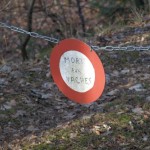 Some local feud? Another day, the school inspector’s two goats came bounding up to the fence anticipating a change of diet from snow and frozen grass, while Vozelle’s dog seemed to be trying to marshal his geese into noisily honking military formations. One walk brought us out by a small riding school with an unexpected life-sized figure of a horse beautifully fashioned out of horseshoes.
Some local feud? Another day, the school inspector’s two goats came bounding up to the fence anticipating a change of diet from snow and frozen grass, while Vozelle’s dog seemed to be trying to marshal his geese into noisily honking military formations. One walk brought us out by a small riding school with an unexpected life-sized figure of a horse beautifully fashioned out of horseshoes.
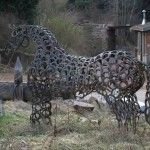 A bit further afield we came across a newly cleaned tombstone on the edge of the woods to a villager who’d died up there in 1869, and then followed a small arrow pointing downhill to an old copper mine which had been recently re-excavated. It wasn’t on our map, so must have been forgotten since its initial excavation in the seventeenth century. And on another day we headed up a valley to a hillside with a gravestone that was marked on the map – that of the splendidly named Claude Theophile Funck-Brentano who died there in February 1916.
A bit further afield we came across a newly cleaned tombstone on the edge of the woods to a villager who’d died up there in 1869, and then followed a small arrow pointing downhill to an old copper mine which had been recently re-excavated. It wasn’t on our map, so must have been forgotten since its initial excavation in the seventeenth century. And on another day we headed up a valley to a hillside with a gravestone that was marked on the map – that of the splendidly named Claude Theophile Funck-Brentano who died there in February 1916.
It was rather nice one sunny day to have a change of walking landscape from pine forests and snow to vineyards. Roger and Dorinda had asked if we’d like to join them in trying out Virginie’s winstub in Colmar. (Virginie was the waitress who’d left the Blanche Neige before Christmas to take on a traditional winstub in the Petite Venise canal area of Colmar.) It was a tiny downstairs room with about 9 tables, a bar, a couple of old stoves to keep food hot, and sepia photographs on the walls. She showed us the upstairs room that she and her partner had converted from the old proprietors’ sitting room to an additional dining area. She remembered us as soon as we walked in and made quite a fuss of us. We got funny looks from the other diners when we got extra delicacies at the beginning and end. And all the portions were generous – a single course would be quite sufficient another time! Anyway after our two courses and extra bits, we definitely needed a walk, and stopped by a track through the vineyards above Sigolsheim. Below us lay the winemakers where we had bought Christmas wine, and above us lay the Vogelgarten where the grapes for that particular pinot gris were grown. In all the small plots, men were busy pruning and weeding in the sunshine as we ambled up the hill.
And the champagne? That has come out on quite a few occasions. First there was Epiphany, celebrated here by the whirling pensioners of Ste Marguerite with much dancing, champagne, brioche and finally galette des rois. Most of the dancing was elegantly accomplished, but a couple from my table cleared the floor with their extraordinary jive which involved wild leg and arm movements and stiff, angry crouching. The rest of my table were murmuring in horror at this very unchic demonstration. “He looks like a bear” whispered one lady. “Did I dance well?” asked the lady, heavily perspiring, makeup running, as she returned to our table and leaned over me. I hesitated for words. Thinking she hadn’t made herself understood, she repeated her question insistently. “Quite extraordinary!” was the best I could manage.
Following the lotto (bingo), and Mme Laine’s triumphant win, I didn’t make it back to the monthly gathering of the anciens of Entre-deux-Eaux until February. I settled down to try and follow the intricacies of the game of tarot, with all its extra cards. Then one of our neighbours bore me off to indulge me in a game of Scrabble, and we were soon joined by others. It was surprisingly successful and sociable, interrupted only by coffee and brioche, then some beignets for Lent, and later still, ignoring Lent, by gateaux and champagne. A man with a clarinet who seems to know two basic tunes, “Michael row the boat ashore” and “Happy birthday” struck up the latter three times as the three cream-rich cakes were cut for three birthdays. It was such fun that I went back yesterday. Two birthdays this month, so more cake and champagne. But the Scrabble got serious, arguments ensued, a dictionary was demanded and the mayor’s office raided for one. Mme Laine looked bewildered by the passion for mere words and I felt quite exhausted by the scoring!
Roger and Dorinda continue to come and go between the Vosges and Surrey, and John often cooks a meal to welcome them back. On the last such occasion, he emerged from inspecting the wine racks down in one of the barns to announce that he’d noticed some bottles of champagne that we must have forgotten about, – some from his sixtieth birthday and some that could only have come from my fiftieth birthday all those years ago. Since Roger was about to celebrate his 65th birthday a couple of days later, we opened the 15-year old bottle, hoping it was a good keeper, and toasted all these landmarks, past and present. It was lovely still. Ageing obviously suited it!
We celebrated Roger’s actual birthday at the purple restaurant in Epinal. Then a week later, on a misty dull morning, Dorinda rang to say they’d decided to drive up to a restaurant near Sarrebourg for lunch and would we like to join them there? John consulted the internet and discovered that it had, that very day, been awarded a Michelin star. So he was easily convinced. We drove north to Baccarat, then branched off on a rolling cross-country road. On either side, strange white poles emerged from the ground only to be enveloped by mist. When the mist lifter later we realised that we were surrounded by wind turbines. Then the scenery changed and we were in a flat wet landscape of scrubby forests, lakes, streams and canals with all kinds of water fowl. In summer, with a few cafés opening up by the waterside it must be very picturesque.
Chez Michele was on the main street of the very small village of Languimberg, opposite the church, and apart from its fresh coat of paint looked much like any other village house. But as we walked in through the bar to join Roger and Dorinda, we were ushered into a large conservatory at the rear. Surrounded by green bamboo outside and decorated entirely in white – tablecloth, napkins, flowers,- it looked unexpectedly bridal and lush. 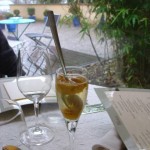 Dorinda’s glass provided the only hint of golden colour. It looked tempting, so I ordered one too – champagne and mirabelle (the yellow plum of Lorraine). We all enjoyed the change of scene, though the food was nothing special and the Blanche Neige and the Frankenbourg still remain firm favourites (and sadly the Blanche Neige still hasn’t received a Michelin star). At the end of our leisurely lunch John and I set out to see the fabulous sounding Chagall Tree of Life window in Sarrebourg. But of course, being March the chapel was firmly closed for renovation works. Shame.
Dorinda’s glass provided the only hint of golden colour. It looked tempting, so I ordered one too – champagne and mirabelle (the yellow plum of Lorraine). We all enjoyed the change of scene, though the food was nothing special and the Blanche Neige and the Frankenbourg still remain firm favourites (and sadly the Blanche Neige still hasn’t received a Michelin star). At the end of our leisurely lunch John and I set out to see the fabulous sounding Chagall Tree of Life window in Sarrebourg. But of course, being March the chapel was firmly closed for renovation works. Shame.
Meanwhile, back in Entre-deux-Eaux, winter life continues as usual. Farmer Duhaut and Olivier have been spraying the fields liberally with liquid cow manure each time rain or snow is expected. In the same period, all the human sewage arrangements have been officially inspected by a charming young lady in wellington boots. Apparently she got a hostile reception from many villagers, as not only did certificates of emptying have to be provided, but to add insult to injury, around £60 would be charged for an inspection no-one wanted. And at least we knew where ours was. We were fortunate that we had good plans of the more recent parts of our system, and were able to clear and lift most of the lids from the inspection points before the heavy frosts. Only one was too frozen to inspect. Our official report wasn’t too bad.
On the pest and blight front, outside John was anxious to get the sawn off branches from fireblighted apple trees burnt, but the wood was still too damp. And indoors we had processions of small white caterpillars wiggling across the ceiling. It took over a week to track them back to a bowl of walnuts and decide that they would soon be turning into codling moths. But fear not, if we gave you walnuts at Christmas – they were a more recent vintage!
And finally, at some stage between snow, rain, 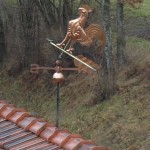 and attempted bonfires, when gales were particularly strong, our golden (well, bronze-ish) weather vane cock keeled over at a drunken angle, and John feared it would snap off and crash down on some passing car or tractor. But the workshop roof was too slippery with either snow or frost for John to rescue it. It was a couple of weeks before it was safe enough for him to climb up and restore the fowl to a proud upright. Its arrow is, at this very moment, pointing to the south.
and attempted bonfires, when gales were particularly strong, our golden (well, bronze-ish) weather vane cock keeled over at a drunken angle, and John feared it would snap off and crash down on some passing car or tractor. But the workshop roof was too slippery with either snow or frost for John to rescue it. It was a couple of weeks before it was safe enough for him to climb up and restore the fowl to a proud upright. Its arrow is, at this very moment, pointing to the south.
So cocorico (sounds more convincing than cock-a-doodle-do) and au revoir as winter continues (unofficially) here.


